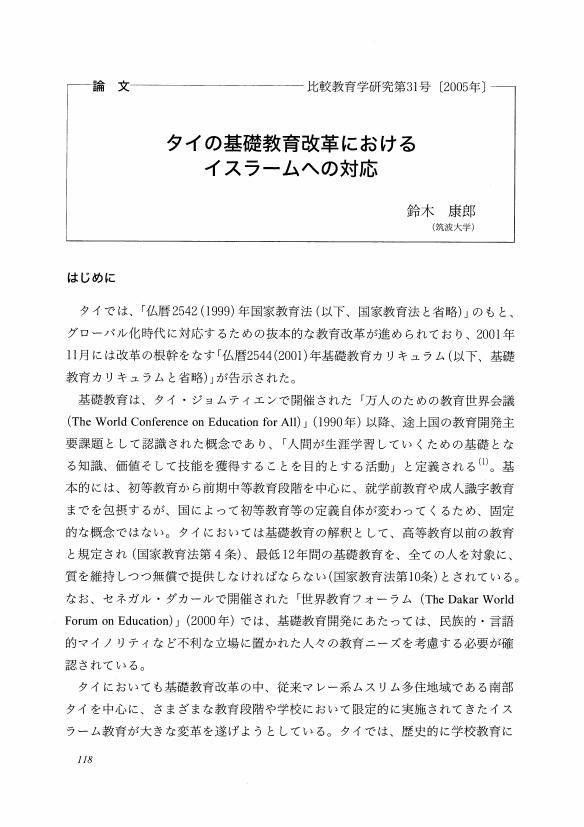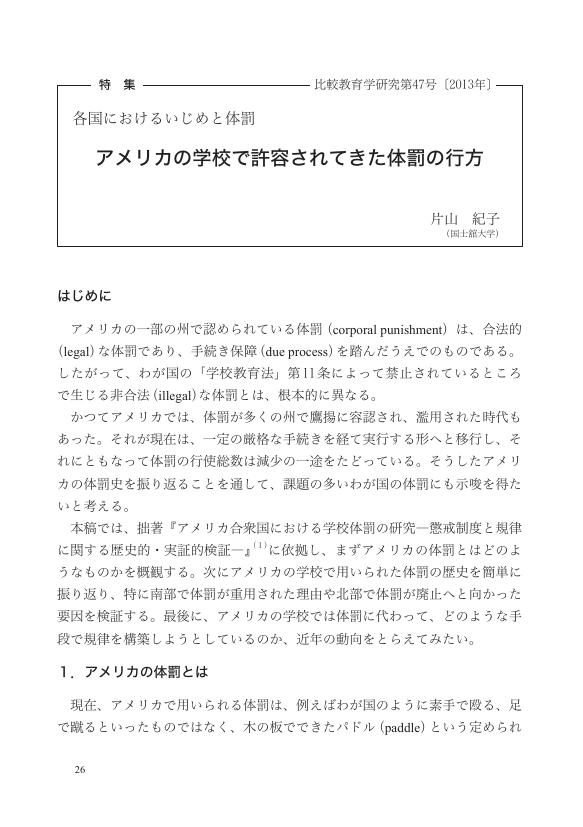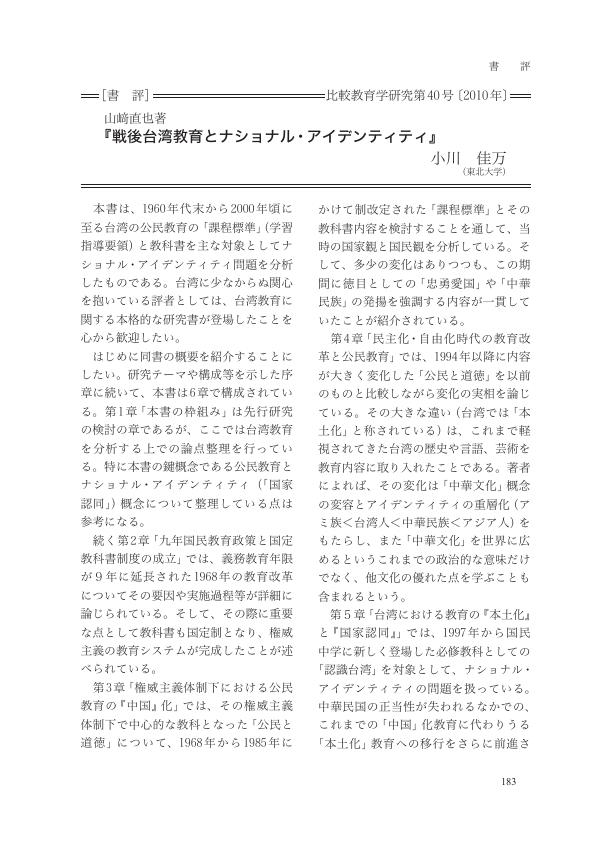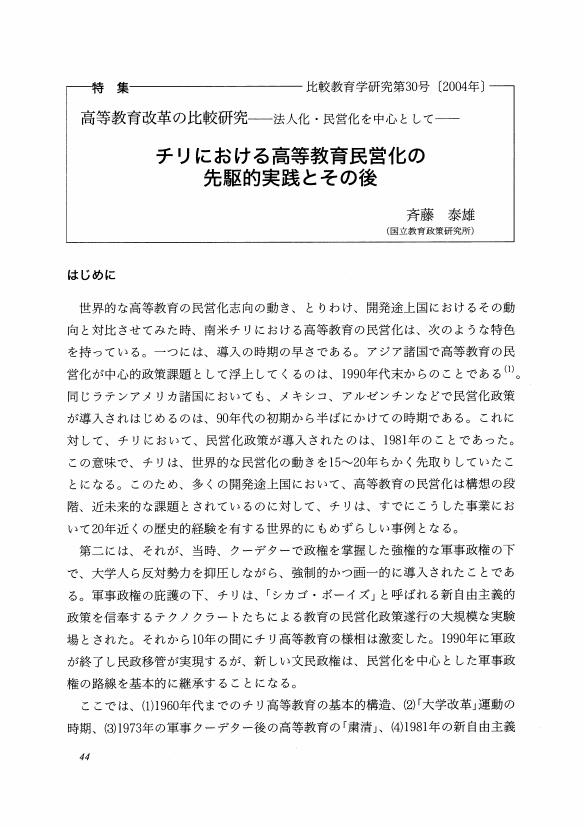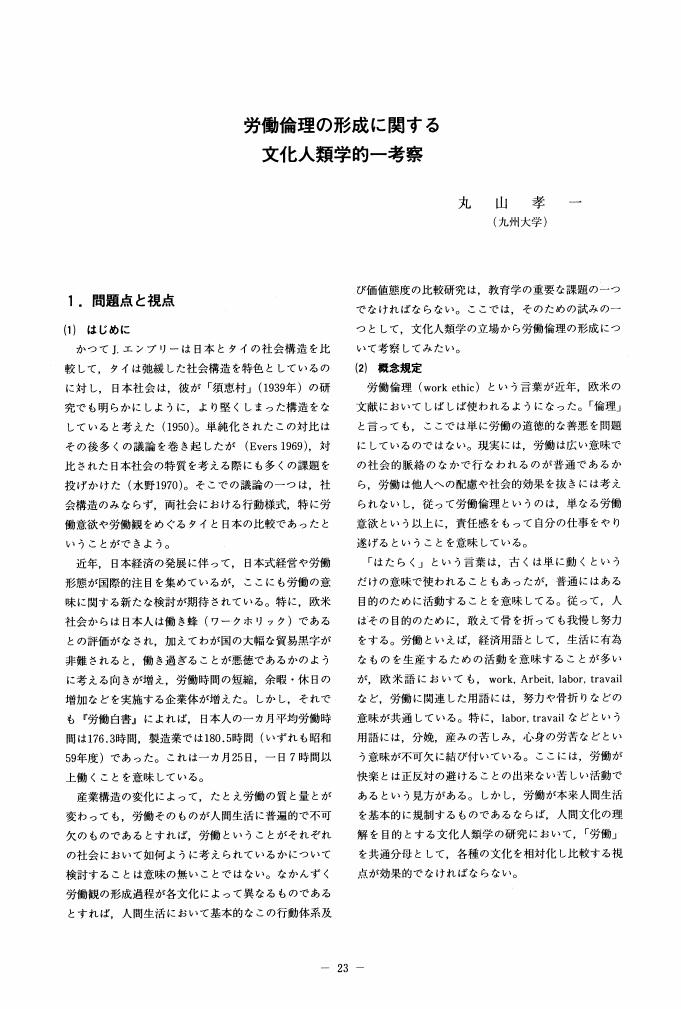2 0 0 0 OA マリオンM. スコットと日本の教育
2 0 0 0 OA タイの基礎教育改革におけるイスラームへの対応
- 著者
- 鈴木 康郎
- 出版者
- 日本比較教育学会
- 雑誌
- 比較教育学研究 (ISSN:09166785)
- 巻号頁・発行日
- vol.2005, no.31, pp.118-137, 2005-06-25 (Released:2011-01-27)
- 著者
- 安藤 万奈
- 出版者
- 日本比較教育学会
- 雑誌
- 比較教育学研究 (ISSN:09166785)
- 巻号頁・発行日
- no.37, pp.46-56, 2008
1 0 0 0 OA アメリカの学校で許容されてきた体罰の行方
1 0 0 0 OA 山﨑直也著『戦後台湾教育とナショナル・アイデンティティ』
- 著者
- 小川 佳万
- 出版者
- 日本比較教育学会
- 雑誌
- 比較教育学研究 (ISSN:09166785)
- 巻号頁・発行日
- vol.2010, no.40, pp.183-185, 2010 (Released:2023-07-19)
- 著者
- 松本 麻人
- 出版者
- 日本比較教育学会
- 雑誌
- 比較教育学研究 (ISSN:09166785)
- 巻号頁・発行日
- vol.2020, no.61, pp.183-205, 2020 (Released:2023-07-19)
About 40% of private 4-year universities in South Korea are Christian. Although half are ex-Christian theological seminaries, the transformative development process that was involved in their establishment as universities has not been discussed thus far. This paper focuses on the fact that the seminaries, which were unrecognized in the 1980s, were approved as miscellaneous schools as part of a government-controlled, pre-university promotion process. The purpose of this paper is to clarify the influence that these schools later exerted on Christian universities’ development by examining the offensive and defensive process between national policies on unrecognized seminaries, the various strategies that seminaries used, and the transformation that has taken place with. We will discuss how the seminaries’ transformation into miscellaneous schools has contributed to establishment Christian universities. In this paper, we use Barton R. Clark’s triangle model as a theoretical framework. This model sets the state, society, and university as influential factors in the transformation of higher education organizations. This paper adds religious society as an influential factor in the transformation of seminaries. Relevant literature was reviewed in order to explore the details that pertain to government measures and responses from affected seminaries. We referred to published parliamentary minutes, government documents and statistics, and historical school materials. We obtained public government documents that have not been released to the public by requesting the information from government records archives. Moreover, in order to clarify the seminaries’ correspondence, we referred to literature that was in addition to each university’s school history. The 1970s, increase in the number of Christians coupled with the government’s growing restrictions on higher education meant that minister training was outpaced, resulting in many unrecognized seminaries. The government complained that these seminaries were recruiting students for themselves as “schools” and illegally granting degrees. The government then formulated a plan to control such seminaries. An announcement was made that seminaries that meet certain standards would be promoted to universities or miscellaneous schools, and the rest would be closed. The government has also sought to incorporate high-quality seminaries into their higher education system, increasing their capacities and providing financial support. Many seminaries applied for approval given the importance of their maintenance as minister-training schools. In addition, the recognition of the state as a higher education institution has been important for establishing schools’ social status. Obtaining a status that facilitates senior school entrance is useful for effective functioning as an educator training system since educators would obtain future degrees. It is also evident that the various Christian societies place great importance on the maintenance of their seminaries. However, only a few seminaries have been approved. Christian society revolted over the repeal of many seminaries, but some seminaries supported the government. Therefore, the government succeeded in dividing Christianity society. Seminaries in transition were obliged to comply with laws and regulations relating to facilities and equipment, staffing, teacher qualifications, and curricula. The schools had to include Korean history, national ethics and physical education as required subjects. Despite this, the schools became miscellaneous schools because it was possible to maintain the theology department and the essential function of minister training. (View PDF for the rest of the abstract.)
1 0 0 0 OA ラオスにおける学力調査の現状と格差是正の試み ―地域間格差を中心に―
- 著者
- 乾 美紀
- 出版者
- 日本比較教育学会
- 雑誌
- 比較教育学研究 (ISSN:09166785)
- 巻号頁・発行日
- vol.2017, no.54, pp.174-186, 2017 (Released:2020-08-29)
1 0 0 0 OA フランスの幼児教育 ―学校教育の臨界―
- 著者
- 藤井 穂高
- 出版者
- 日本比較教育学会
- 雑誌
- 比較教育学研究 (ISSN:09166785)
- 巻号頁・発行日
- vol.2021, no.63, pp.18-32, 2021 (Released:2023-07-19)
1 0 0 0 OA 日本の留学生受入れの経済的側面からの分析と政策への示唆 米国との比較から
- 著者
- 佐藤 由利子
- 出版者
- 日本比較教育学会
- 雑誌
- 比較教育学研究 (ISSN:09166785)
- 巻号頁・発行日
- vol.2008, no.37, pp.112-132, 2008-06-25 (Released:2011-01-27)
1 0 0 0 OA 20世紀初頭ドイツにおける日本教育の紹介 吉田熊次の教育勅語講演を事例として
- 著者
- 平田 諭治
- 出版者
- 日本比較教育学会
- 雑誌
- 比較教育学研究 (ISSN:09166785)
- 巻号頁・発行日
- vol.1996, no.22, pp.167-179,221, 1996-06-15 (Released:2011-01-27)
Currently a growing interest in Japan is visible all over the world, owing mainly to its economic importance. In Japan herself, “Internationalization of Education” is being advocated more loudly. Among foreign scholars some misunderstandings concerning Japanese education seem to continue because of the lack of information and their failure of cognition. Japan will have to make efforts to introduce her education more positively and more correctly to other countries, in order to deepen international understanding. It goes without saying that verbal communication needs looking in.
1 0 0 0 OA 高等教育システム改革に関する豪英比較 「二元制」から「一元制」への転換過程
- 著者
- 杉本 和弘
- 出版者
- 日本比較教育学会
- 雑誌
- 比較教育学研究 (ISSN:09166785)
- 巻号頁・発行日
- vol.1998, no.24, pp.141-160, 1998-06-30 (Released:2011-01-27)
The purpose of this paper is to comparatively examine higher education reforms in Australia and Britain, forcusing on the transformation process from binary systems to unitary ones, and to clarify some factors which brought about such a transformation.
- 著者
- 丸山 孝一
- 出版者
- 日本比較教育学会
- 雑誌
- 日本比較教育学会紀要 (ISSN:02871106)
- 巻号頁・発行日
- vol.1987, no.13, pp.23-25, 1987-03-31 (Released:2010-08-06)
- 参考文献数
- 11
1 0 0 0 OA ドイツの大学入学制度改革 ―グローバルな視点から―
- 著者
- 木戸 裕
- 出版者
- 日本比較教育学会
- 雑誌
- 比較教育学研究 (ISSN:09166785)
- 巻号頁・発行日
- vol.2016, no.53, pp.14-27, 2016 (Released:2020-08-29)
1 0 0 0 OA インド高等教育における連邦と州の関係 ―大学教員資格試験制度に着目して―
- 著者
- 渡辺 雅幸
- 出版者
- 日本比較教育学会
- 雑誌
- 比較教育学研究 (ISSN:09166785)
- 巻号頁・発行日
- vol.2016, no.52, pp.47-67, 2016 (Released:2020-08-15)
India has introduced the federal system since independence from the UK, because of the diversity among its various regions. India has also experienced a rapid expansion of its higher education system. The number of students was about 4.9 million in 1990-1991, but this increased to about 23 million in 2013-2014. Previous works revealed relationships between the central government and the local governments in higher education of India as being confrontational. Meanwhile, the University Grants Commission (UGC) has regulated that prospective teachers take a test to earn qualifications to be assistant professor. The UGC administers the test, called the “National Eligibility Test (NET)”. Some state governments also hold similar tests, called “State Eligibility Test (SET)”. NET has been held for more than 25 years, and the total number of the candidates was about 1 million in 2013. This study examines the relationship between the central government and the local governments in higher education of India, by focusing on the qualification system for positions within the academic profession. Indian higher education administers a wide variety of qualification tests. National level tests are held by the UGC and the Council of Industry Science Research (CSIR). The UGC holds tests for the humanities and social sciences. CSIR holds a test for science and technology. Some state governments also hold state level eligibility test. This paper focuses on NET by UGC, so NET means UGC-NET. The central government has assumed leadership in administering UGC-NET, because the test is based on powers “co-ordination and determination of standards” in the national constitution of India. UGC can define “the qualifications that should ordinarily be required of any person to be appointed to the teaching staff of the University” based on its authoritative powers. Since the central government is able to make the local governments obey rules of the test, it proves that the central government has both initiative and final authority. It is important that items of the test are “soft”, not “hard”. If UGC becomes involved in a part of “hard”, especially at universities, UGC is likely to conflict with local government powers as provided in the constitution. However the UGC has not only administered the NET, but also permitted local governments to do SET using local languages and subjects related to these languages, because of the diversity of languages. UGC accredits both state identified agencies and determines student performance. The candidates are eligible for taking the tests if they have secured at least 55% grade in their Masters Degree. The tests consist of three papers. All the three papers consist of only objective type questions. Paper 1 is general in nature, intended to assess the teaching/research aptitude of the candidate. Paper 2 consists of basic questions from the subject selected by each candidate. Paper 3 consists of advanced questions from the subject as selected by the candidate. The pass rate of the tests in 2013-14 was around 4-5%. In other words, the central government prepares mechanisms not only to accommodate their diversity, but also unify them. Moreover, UGC has permitted SET to have local subjects related to their languages and then added their subjects to NET. For example, the agency of North East State Eligibility Test (NE-SET) has adopted Bodo as a subject of the SET since 2003. Bodo is spoken in Assam, and is a minority language in India. UGC also adopted Bodo as a subject of NET since 2010. The Bodo community hailed the recognition of its language and culture. One reason was that the adaption would boost the preservation and promotion of its people. The other reason was that candidates of Bodo in NET might obtain a Junior Research Fellowship of UGC and therefore boost the research of the Bodo, (View PDF for the rest of the abstract.)
- 著者
- 中村 浩子
- 出版者
- 日本比較教育学会
- 雑誌
- 比較教育学研究 (ISSN:09166785)
- 巻号頁・発行日
- vol.2016, no.52, pp.113-135, 2016 (Released:2020-08-15)
The ‘Tomorrow’s Schools’ reform in New Zealand since the late 1980’s has been known as a typical realisation of a new public management (NPM) model. How and why was the reform carried out in a manner that was extremely thorough and loyal to the NPM model, and what philosophical and political currents shaped the reform? This paper articulates five political currents that set the stage for the reform: democratic formulation by the Left, new institutional economics, managerialism, the New Right, and Tino Rangatiratanga. The paper also explores the political situation surrounding the Kura Kaupapa Māori that became state schools under the ‘Tomorrow’s Schools’ reform. It investigates how the Kura Kauappa Māori gained the status of state schools despite impediments. The political position evident in the Educational Development Conference of 1974 and ‘The Curriculum Review’ of 1984 have been termed liberal progressive, participatory democracy, or democratic populism. The Review was published under the Fourth Labour Government based on extensive public consultations. Its anti-racist, anti-sexist message emphasising the partnership of students, teachers, families, and the community was widely accepted by the Left camp and educationalists. ‘Government Management’, released in 1987 by the Treasury, reflected the new institutional economics that incorporated public choice, transaction cost, and agency theory. Although it valued the community involvement promoted by ‘The Review’, it argued for the partnership through the market order claiming that it would otherwise only promote the interests of the middle class or those of the institutions. The Picot Report, the blueprint for the reform, was the product of a compromise, as has been interpreted, between the Left and new institutional economics, both of which validated the partnership. However, the coming into power of the National Party in 1990 changed the balance. Managerialism, based on the belief that improved management resolves economic and social malaise, manifested itself in ‘Today’s Schools’ under the National government in 1990, led by the initiative of the Treasury and the State Services Commission. The report argued for clearer definitions that the Board of Trustees would take on the role of governance and the principal of management. The report, emphasising the managerial model rather than a cooperative decision-making one, marked the introduction of the NPM model constituted of new institutional economics and managerialism. The New Right thinking was apparent in ‘New Zealand Schools’, a report by Sexton, an educational advisor for the Thatcher government, who was entrusted by the Business Roundtable to write the report. The report sharpened the contentions of institutional economics and managerialism, contained arguments common to those by Friedman and Hayek, and confronted the leftist idea of democratic control by the citizens. Moreover, although ‘Government Management’ and ‘Today’s Schools’ both appreciated the Treaty of Waitangi and apprehended the state’s role in reviving the cultural heritage of the Māori, Sexton dismissed its importance. Equity interests in ‘Government Management’ and ‘Today’s Schools’ indicate the influence of Tino Rangatiratanga or the Māori self-determination movement at the time of the reform. Gaining impetus in the 1970s, total Māori immersion preschools, Kōhanga Reo, were created and soon attended by almost half the Māori preschool children in New Zealand. This was followed by the opening of Kura Kaupapa Māori, the total immersion schools, and the attainment of legal recognition under the Tomorrow’s Schools reform as state schools. Although the movement, as the movement leader reflects, took advantage of the change to gain the status of state schools, it can be considered that for the contender of institutional (View PDF for the rest of the abstract.)
1 0 0 0 OA カナダにおける二言語教育をめぐる政治力学 ウクライナ系カナダ人の場合を中心として
- 著者
- 江淵 一公
- 出版者
- 日本比較教育学会
- 雑誌
- 日本比較教育学会紀要 (ISSN:02871106)
- 巻号頁・発行日
- vol.1987, no.13, pp.61-67, 1987-03-31 (Released:2010-08-06)
- 参考文献数
- 20
1 0 0 0 OA 比較教育再考 -日本的特質解明のための比較研究のすすめ-
- 著者
- 喜多村 和之
- 出版者
- 日本比較教育学会
- 雑誌
- 比較教育学研究 (ISSN:09166785)
- 巻号頁・発行日
- vol.2001, no.27, pp.238, 2001
- 著者
- 木村 裕
- 出版者
- 日本比較教育学会
- 雑誌
- 比較教育学研究 = Comparative education : bulletin of the Japan Comparative Education Society (ISSN:09166785)
- 巻号頁・発行日
- no.58, pp.75-94, 2019

